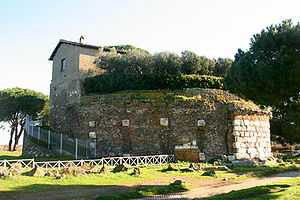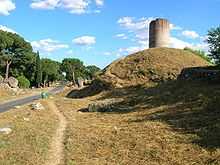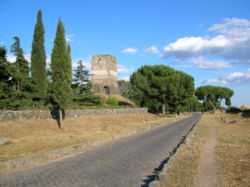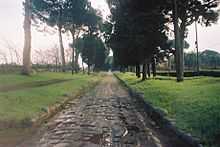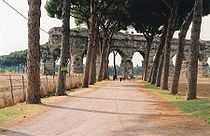Appian Way Regional Park
Coordinates: 41°50′32.84″N 12°31′42.52″E / 41.8424556°N 12.5284778°E The Appian Way Regional Park is a protected area of around 3400 hectares, established by the Italian region of Latium. It falls primarily within the territory of Rome but parts also extend into the neighbouring towns of Ciampino and Marino.
The Park
The park aims to be a "green wedge" between the centre of Rome and the Alban Hills to the southeast. It contains a majority of the relics of Ancient Rome to be found outside the city centre. It consists of the Appian Way, from the centre of Rome to the 10th Mile, including the Villa of the Quintilii; the Park of the Caffarella; the Tombs of Via Latina archaeological zone; and the Aqueduct Park as well as other areas not accessible to the public.
History
The idea of a great archaeological park between the Roman Forum and the Alban Hills dates back to Napoleonic times. However, it was Pope Pius IX who took the first steps to organize the archaeological ruins of the Appian Way, with the assistance of Luigi Canina. After Italian unification further efforts were made to develop an archaeological walk to the southeast of the city centre, but this only reached as far as the Baths of Caracalla.[1] In 1931, a new plan envisaged the Appian Way to become a great park but this idea was threatened after the Second World War with the construction of illegal housing and sports clubs close to the monuments. Moreover, the new ring road for Rome, the "Grande raccordo anulare", cut in two the Appian Way at the seventh mile, a mistake that was only rectified with the construction of a tunnel before the Great Jubilee of 2000.[1] The Park finally became a reality in 1988 and in 2002 it was expanded with the purchase of an area known as the Tor Marancia. The Park remains 95% in private hands: 40% is held by aristocratic Roman families; 25% by companies; 21% by small landowners and 10% by the Catholic Church.[1] There remain ambitious plans to extend the Park all the way into Rome as far as the Roman Forum in one direction, and as far as the Castelli Romani park in the other. [2]
The Appian Way
The Appian Way (Latin and Italian: Via Appia) was one of the earliest and strategically most important Roman roads of ancient Rome. It connected Rome to Brindisi in southeast Italy. After the fall of the Roman Empire, the road fell out of use. On the orders of Pope Pius VI the road was restored and a new Appian Way was built in 1784 in parallel with the old one, as far as the Alban Hills. The new road is the Via Appia Nuova ("New Appian Way") as opposed to the old section, now known as Via Appia Antica. Mile 1 to Mile 10 falls within the Regional Park. Noted monuments along the route include Porta Appia (Porta San Sebastiano), the gate of the Aurelian Walls, the Tomb of Priscilla, the Circus of Maxentius, the Tomb of Cecilia Metella, the Roman baths of Capo di Bove, the Tomb of Hilarus Fuscus, the Mausoleum of the Orazi and Curiazi and the Mausoleum of Casal Rotondo. In places along this stretch of the road the original surface of volcanic rock is exposed.
Via Latina Tombs
The Tombs of Via Latina are Roman tombs, mainly from the 2nd century AD, that are found along a short stretch of the old Roman road of Via Latina, on the southeast outskirts of Rome, within the Regional Park. They now constitute an archaeological park and can be visited. The tombs were discovered in 1857-58. Excavations supported by Pope Pius IX subsequently uncovered various sepulchers and tombs along a 450m stretch of the old road.
Caffarella Park
The Caffarella Park is a large park, protected from development. The park is contained in the Caffarella Valley and is bordered on its northern side by the Via Latina and on its southern by the Appian Way. It extends lengthways from the Aurelian Wall up to the Via dell'Almone and contains several items of archaeological interest, as well as a working farm, and has considerable ecological value, with 78 species of birds and fauna.[3] In Roman times much of the area was occupied by a large estate known as the Triopius. Herodes Atticus was a Greek who became a Roman senator and through his marriage to Annia Regilla he acquired the land of the estate. Two ruins in the park date from that time, the tomb of Annia Regilla and the Nympheum of Egeria.
Aqueduct Park
The Parco degli Acquedotti is a public park of approximately 15 ha. The park is named after the aqueducts that dissect it, the Aqua Felix and the Aqua Claudia. It also contains the remains of the Villa delle Vignacce [4] to the North West.
Villa of the Quintilii
The Villa of the Quintilii (Italian: Villa dei Quintili) is an ancient Roman villa beyond the fifth mile of the Appian Way. It was built by the brothers Sextus Quintilius Maximus and Sextus Quintilius Condianus during the 2nd century.[5] The villa included extensive thermae fed by its own aqueduct, and a hippodrome, dating from the fourth century. The emperor Commodus coveted the villa strongly enough to put to death the brothers in 182 and confiscate it for himself.
Tor Marancia
Slightly to the west of the main park area, Tor Marancia is an undulating, wooded area containing considerable biodiversity for an area so close to Rome's suburbs. [6]
See also
In addition to sites from ancient Rome, the Regional Park includes, or borders on, many religious sites and other points of interest, including:
- Catacomb of Callixtus
- Church of Domine Quo Vadis
- Saint Sebastion outside the Walls
- Church of Sant'Urbano alla Caffarella
- Ardeatine Caves. Site of massacre of Roman citizens by Germans during World War Two.
Photo Gallery
References
- ↑ 1.0 1.1 1.2 url=http://www.parcoappiaantica.it/it/testi.asp
- ↑ Guida Turistica Del Parco Dell'Appia Antica. Parco Regionale Dell'Appia Antica.
- ↑ The Caffarella Valley. Pamphlet produced by the Parco Regionale dell'Appia Antica
- ↑ Sam McVane "The Villa delle Vignacce at Rome, Italy"
- ↑ A. Ricci, Le villa dei Quintilii (Rome 1998)
- ↑ Guida Turistica Del Parco Dell'Appia Antica. Parco Regionale Dell'Appia Antica.
